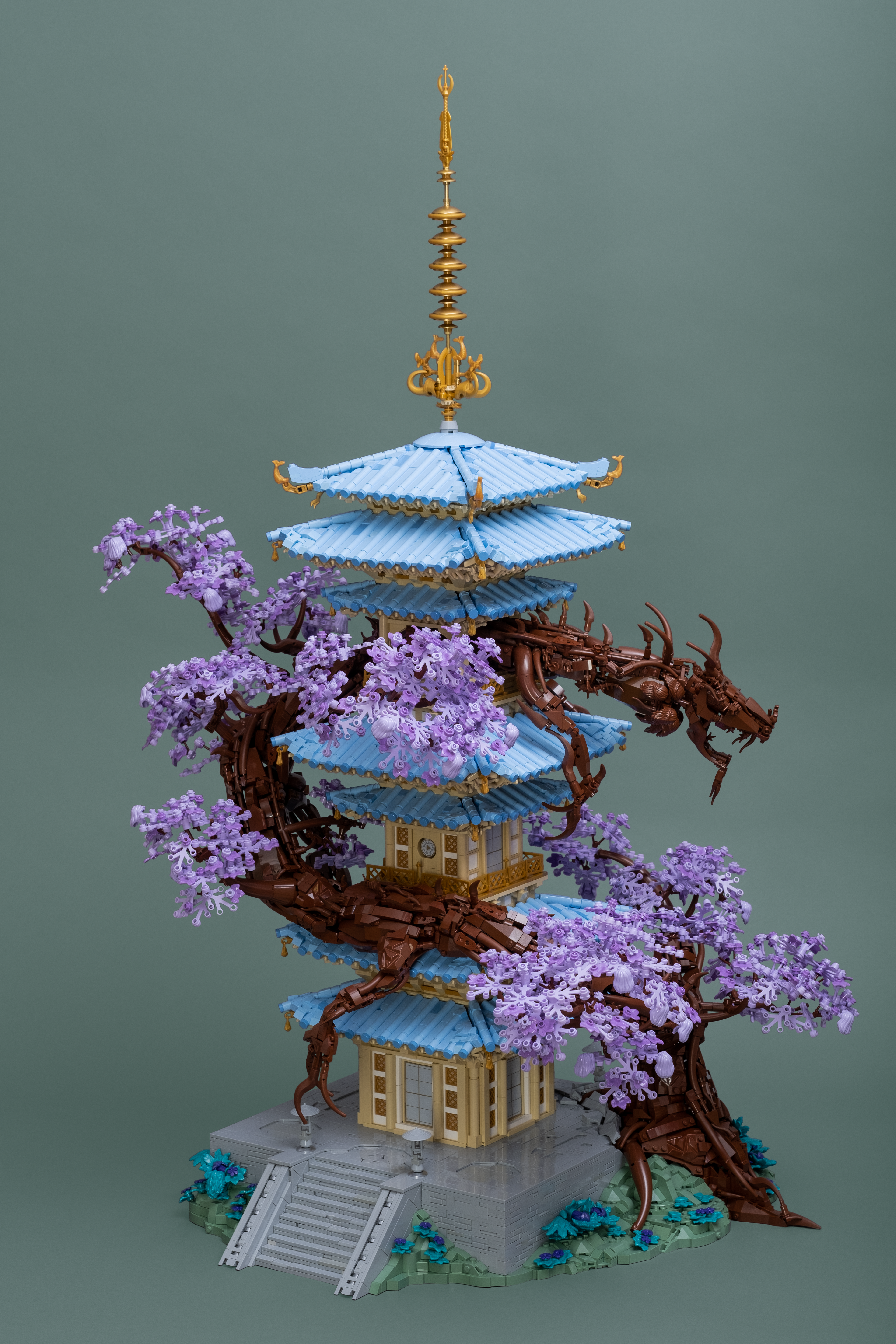日高川に飛び込んだあたしの体は、大蛇になっていた…
("After I dived into the Hidaka River, my body had already turned into a serpent")
In 2017 the LEGO® House opened its doors in Billund, Denmark. A passion project of Kjeld Kirk Kristiansen, the House serves as a new centre for the LEGO® Group and a unique experience hub for customers. It has the appearance of a pyramid made with LEGO® bricks, with each brick being one distinct room. The brick at the very top is called the Masterpiece Gallery, an exhibition space for LEGO® creations made by fans from all around the world. Every year, a new selection of models is on display, chosen by a committee. In 2020 I was invited to showcase some of my models there. But due to the effects of the global pandemic, the exhibition was delayed multiple times. In September of 2022, I could finally put my works on display.
When I was invited, I initially did not intend to build a model specifically for the exhibit. But the additional time gained from the two year delay made me reconsider. There are many things I always wanted to build and many unfinished and half-realised ideas. So for this model I tried to fulfil three main desires: Firstly, I wanted to build something beautiful and visually striking. A model that tells an ambiguous story in itself, without any motion. Secondly, I am fascinated by east-asian architecture and planned to build a pagoda for a while now. Therefore I wanted the main building of the model to be such a structure. And lastly, I saw a lot of potential in the building-technique I developed to make the bonsai a few years ago. I wanted to experiment more with this building style and create an even more organic shape.
The finished model is the accumulation of those ideas: A tree, twisted into the shape of a serpent-dragon as if it is possessed by a spirit. This is 清姫 [kiyohime].
On his pilgrimage, Anchin, a young priest, met the beautiful Kiyohime, who fell madly in love with him. To his detriment, Anchin did not requite her advances. This caused Kiyohime to fall into a rage and chase him across the land. When he almost escaped, she had to jump into the Hidaka river to follow. In the water, she realised that her body warped into a serpent dragon. In this new form, she caught up to Anchin at Dōjōji where he hid under a Bonshō bell. During her rampage, she wrapped herself around the bell and melted it with her fiery breath, killing the priest.
This is the story of Kiyohime as told in the 道成寺縁起絵巻 [dōjōji engi emaki], a picture scroll from the Muromachi period. The Buddhist temple Dōjōji, where the tale allegedly took place, still exists today and is situated in Hidakagawa, in the Wakayama prefecture of Japan. I already knew that I wanted something in the shape of an animal, but the tale of Kiyohime was the fundamental inspiration behind the tree's design. The image of a serpent dragon wrapping itself around something was essential, however, a bell seemed a bit small. Additionally, I was fascinated by the idea of a raging creature that was born out of something innocent and beautiful. The myth, provided these fundamental concepts, but another source of inspiration helped me form these ideas into a concrete model. That inspiration was shintō.
Shintō is an incredibly broad and very hard to define term. It generally refers to the folklore in Japan, a major cornerstone of its culture. The practice and expression of said folklore, however, varied throughout history. One aspect of it, that always fascinated me, is that shintō is a polytheistic believe. Kami (神), the deities, can be found in all things and their influence is particularly strong in certain locals. Shintō shrines are built at these places and dedicated to the one particular kami, that is said to inhabit it. I find this line of thought quite beautiful, as it highlights nature on a microlevel and not just in broad, all-encompassing terms. At least to me, there is more sense of tranquility in a local connection between men, nature and its spiritual equivalent than there is in distant deities.
But humans are fallible. So I wondered: What would happen if men dedicated a shrine to the wrong kami? Would the local kami be enraged? Would nature itself turn against the blasphemous construction? These questions fuelled the storyline that I envisioned for the model: The local spirit creates a tree which bursts out of the ground and wraps itself around the temple. The shape of the tree was inspired by the aforementioned Kiyohime, as were the colours: Originally I planned for the leaves to be dark blue (Colour-ID 63), as a nod to her transformation in the river, but after finishing the pagoda and most of the tree, I decided on lavender (Colour-ID 154) and medium lavender (Colour-ID 157) leaves instead. These colours are the transition between red and blue, the two tones Kiyohime's clothes are often presented in. Lavender also worked better with the bright light blue (Colour-ID 105) of the pagoda's roof and made the tree look brighter and more fantastical. In addition, the colour change allowed for a larger variety of pieces to be used as leaves, such as flower parts (Part-ID 32607) and LEGO® Minifigure hair pieces (Part-ID 85974).
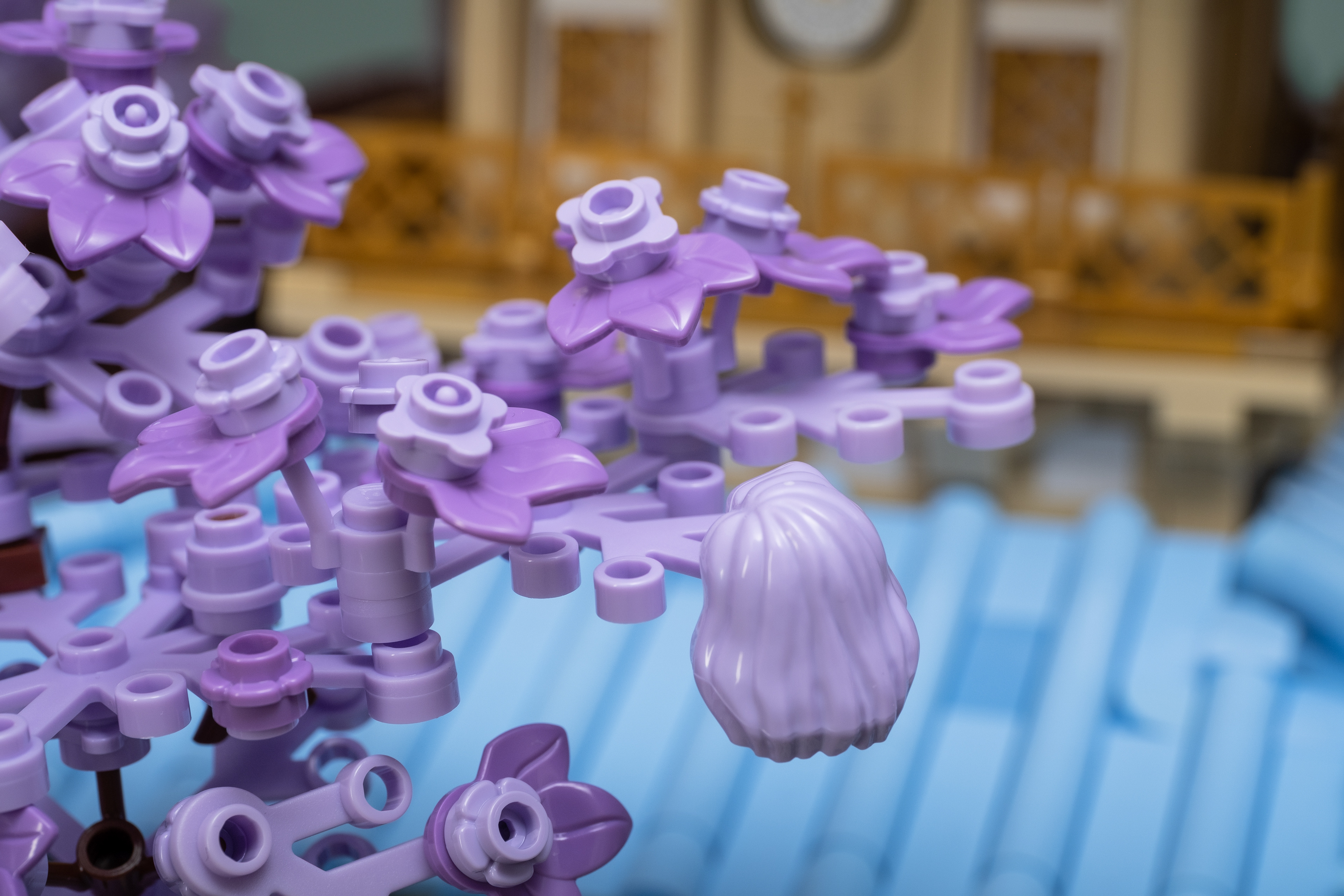
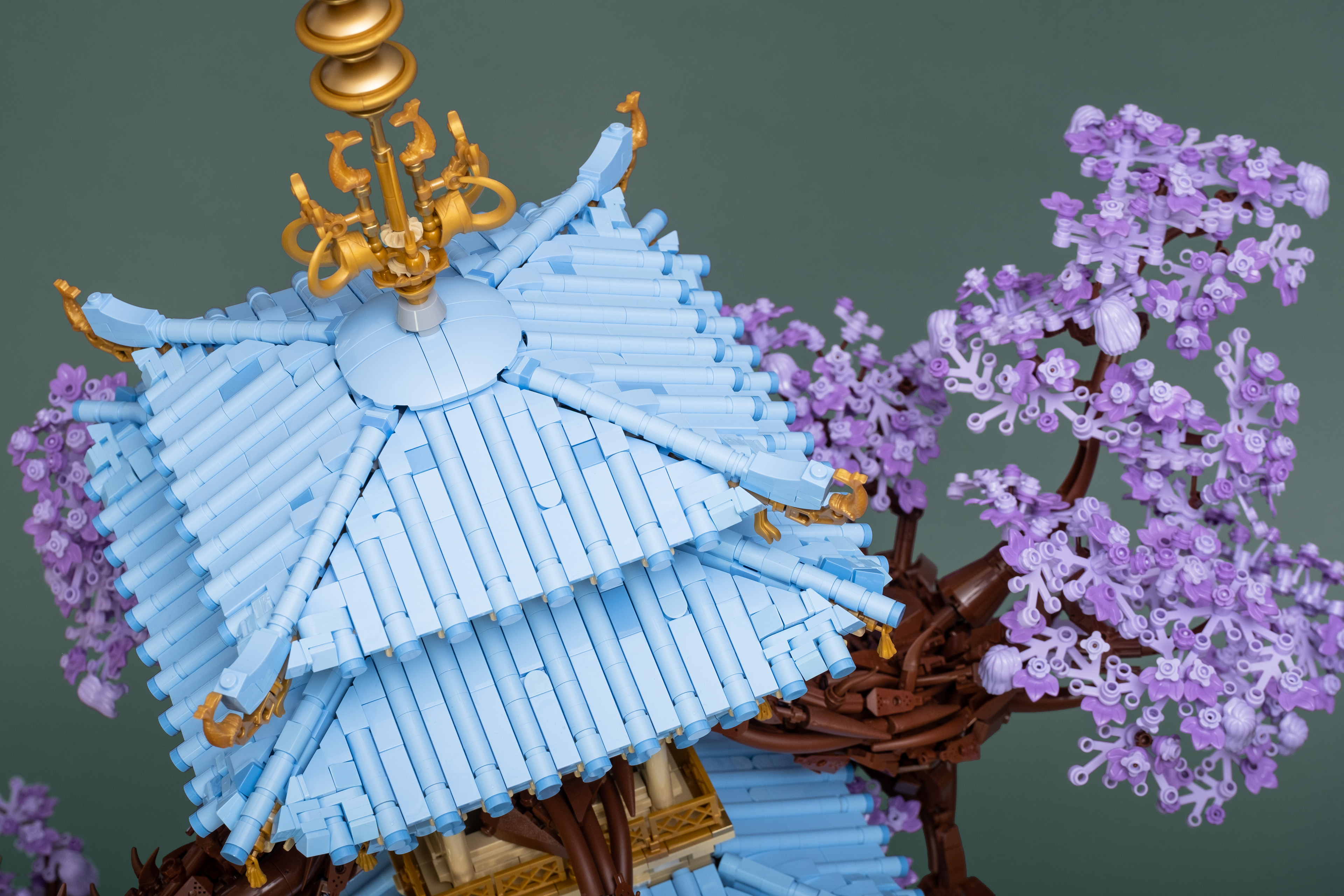
安珍はその先の道成寺に逃げこんだ。
("Anchin fled to the Dōjōji ahead")
When starting the actual building process, the first thing I designed was the dragon's head. I usually use picture references for animal shapes, but in this case, I built it entirely freehand. It is completely asymmetrical with no repeating designs. Even the eyes are made with two different pieces on each side. It is also the only part of the model that I did not redesign at any point during development. Same can not be said about the rest of the tree. My original vision of the model was much, much smaller. I think the final result is about three times as large as my initial concept. There are two main reasons for that. The first sketch for the pagoda was too slim. It did not have the appearance of a sturdy building and had to be about twice as wide as I first thought. Secondly, the dragon's body needed to be much bigger in proportion to the head. As I did not want to remake the head, I had to scale up the rest of the model accordingly.
Most of the tree's design was achieved through trial and error. There were many different ideas that I toyed around with. At one point I wanted the tree to have a full "Ƨ"-shape, but that would have made the tower too tall, so I settled on more of a "?"-shape instead. I also thought about having the tree break through the pagoda at two points instead of just at the top. But doing so would have meant that the curvature of the tree would be quite flat, so I decided to wrap it around the back of the building instead. As for the bark of the tree, I used the same approach as I did with the bonsai and used a mix of LEGO® Technic and LEGO® System parts in reddish brown (Colour-ID 88). There is also a variety of claws (Part-ID 87747 and 11089), horns (Part-ID 13564 and 40379), tails (Part-ID 24204 and 67361), and vines (Part-ID 55236) used all over the tree. In the beginning, I thought each branch of the tree should have leaves, but I realised that that would distract too much from the dragon shape. Therefore, I intentionally shaped some of the branches into limbs and hands. I am particularly happy with the design of the two arms closest to the head, as they appear to wrap around the pagoda's roof.
As I mentioned previously, the tower itself is something that I wanted to build for quite a long time. At some point I considered building a pagoda from the game Ghost of Tsushima before deciding to build a shrine instead. Completely independent from this project, I developed a roof design only using fluted torso pieces (Part-ID 98127pb02) in bright light blue from the LEGO® NINJAGO Movie Collectible Minifigures line. The colour was very rare at that time and there were only a handful of different pieces available, so I thought my part choice worked cleverly around that restriction. But that changed with the release of the Fiat 500 (Set-ID 77942) and the Vespa (Set-ID 10298). Both of these sets introduced a wide array of new parts in bright light blue, and my roof design felt very outdated. I redid it completely and used plates with LEGO® Technic pin holes (Part-ID 11458) instead, as well as 1*1 round bricks (Part-ID 3062b) and wedge slopes (Part-ID 29119 and 29120) for the alignment at the corners. To add some more texture I also sporadically used parts in medium blue (Colour-ID 42).
When building the rest of the tower, the main issue were the proportions. I wanted the tree to be covered as little as possible, which meant the pagoda should be quite narrow. Constructing it that way, however, threw off the balance of the building completely. The first version did not look like a realistic building at all. So I decided to widen the base of the tower. The first floor grew to 15-studs in width, while the second and third floor remained 10-studs wide. But I did not want the pagoda to become narrower towards the top, which meant that all the roofs must have the same width. This presented another problem, because a large roof over a narrow central structure meant a substantial overhang on each side. That would not allow for enough room for the dragon to pass through. In order to create enough space, I incorporated two architectural concepts. First, I built a 14-stud wide veranda, with surrounding fencing (Part-ID 60607), as a base for the second and third floor. That way the roof below each floor could be shorter in length while maintaining the same width. Then, I built smaller roofs above both floors. In Japanese architecture, these are referred to as 裳階[mokoshi], or decorative roofs. They are situated under the actual main roof of a building and usually have different dimensions. Both of these features allowed for more breathing room and enough space for the tree to pass through without it appearing to be squeezed in.
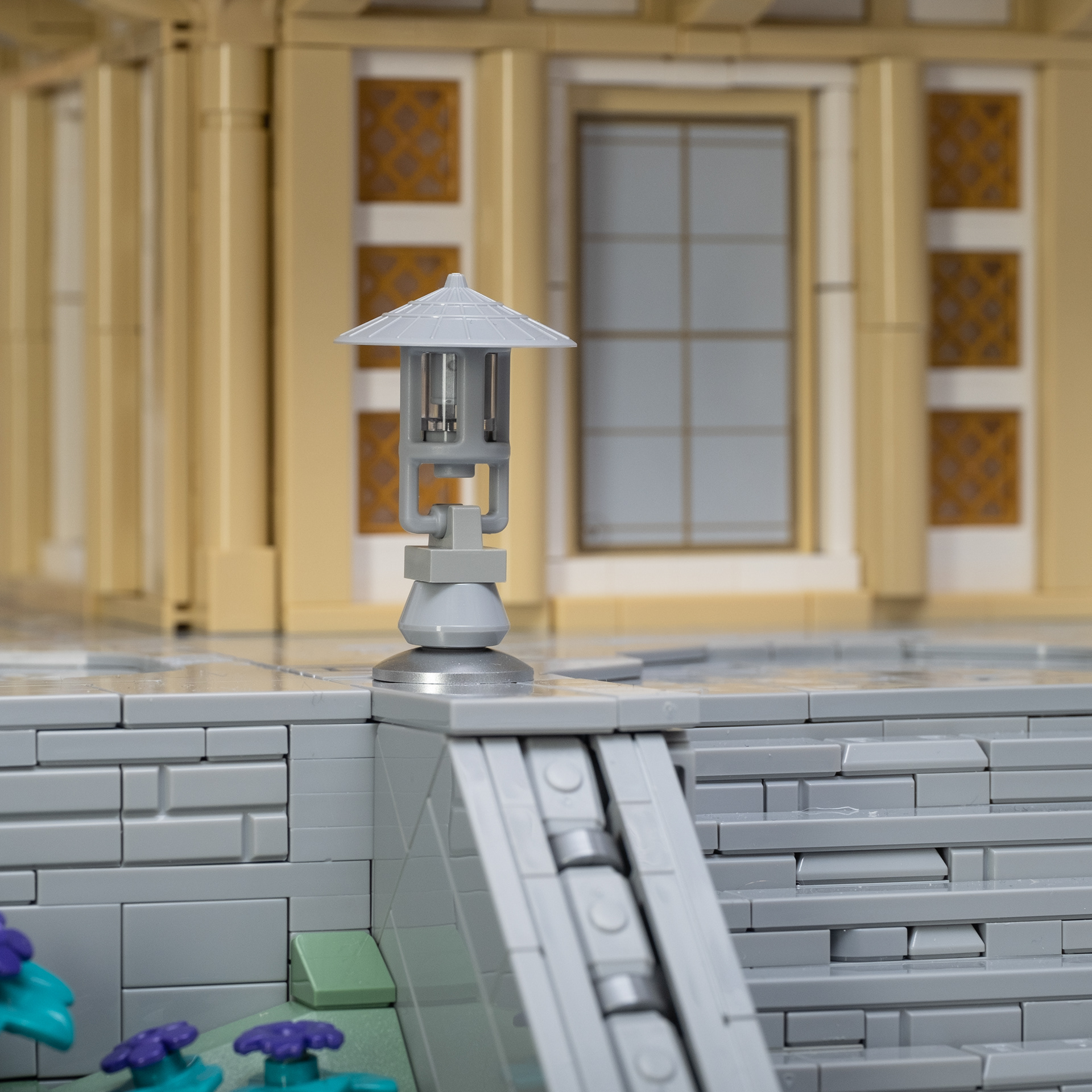
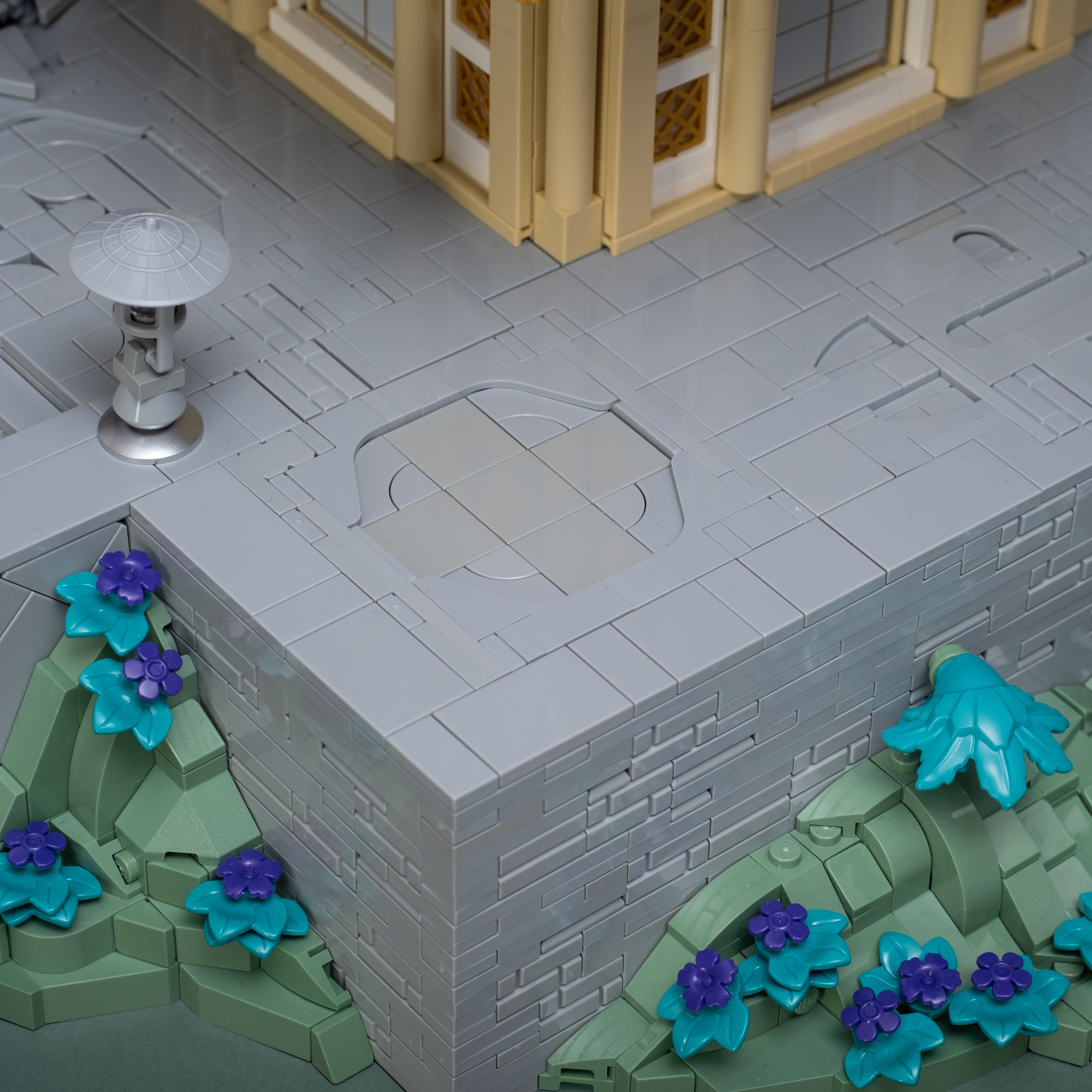
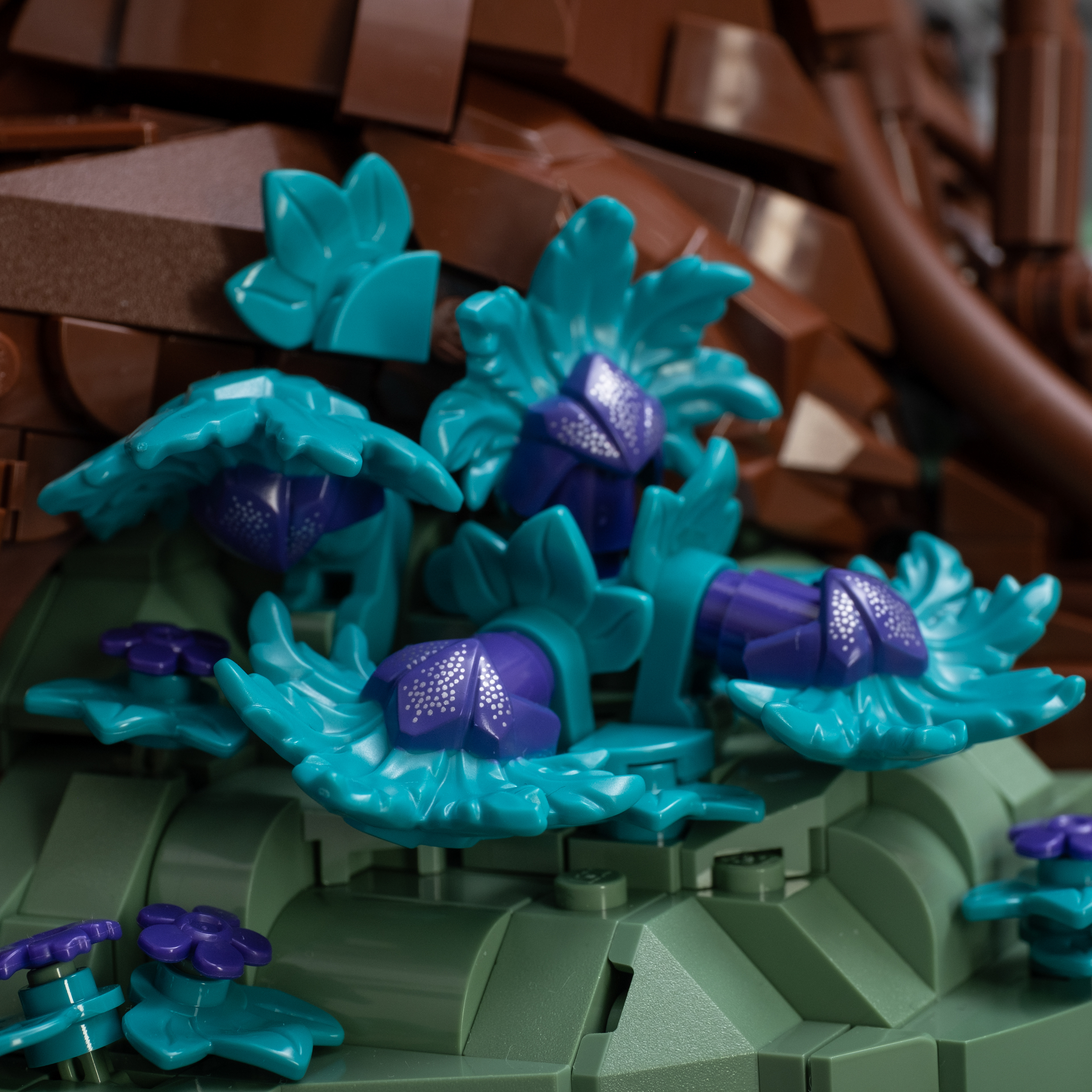
To have a greater contrast with the tree, I did not want the parts of the pagoda to be in any shade of brown. The tower therefore adopts a tan (Colour-ID 2), white (Colour-ID 1) and pearl gold (Colour-ID 115) colour scheme. I wanted the underside of the roofs to have just as much detail as the top side. To achieve this, the wood structure is made out of a multitude of parts such as boomerangs (Part-ID 25892) and cattle horns (Part-ID 64847), as well as crossbows (Part-ID 20105) at the corners. There are a lot of SNOT techniques used to create the white framing of the walls. the most extreme example is the first floor, which, with the exception of the corner pillars (Part-ID 43888), built entirely upside down. To add some even finer detail, I also used two printed parts (Part-ID 57895pb041 and 14769pb217) for the first and second floor.
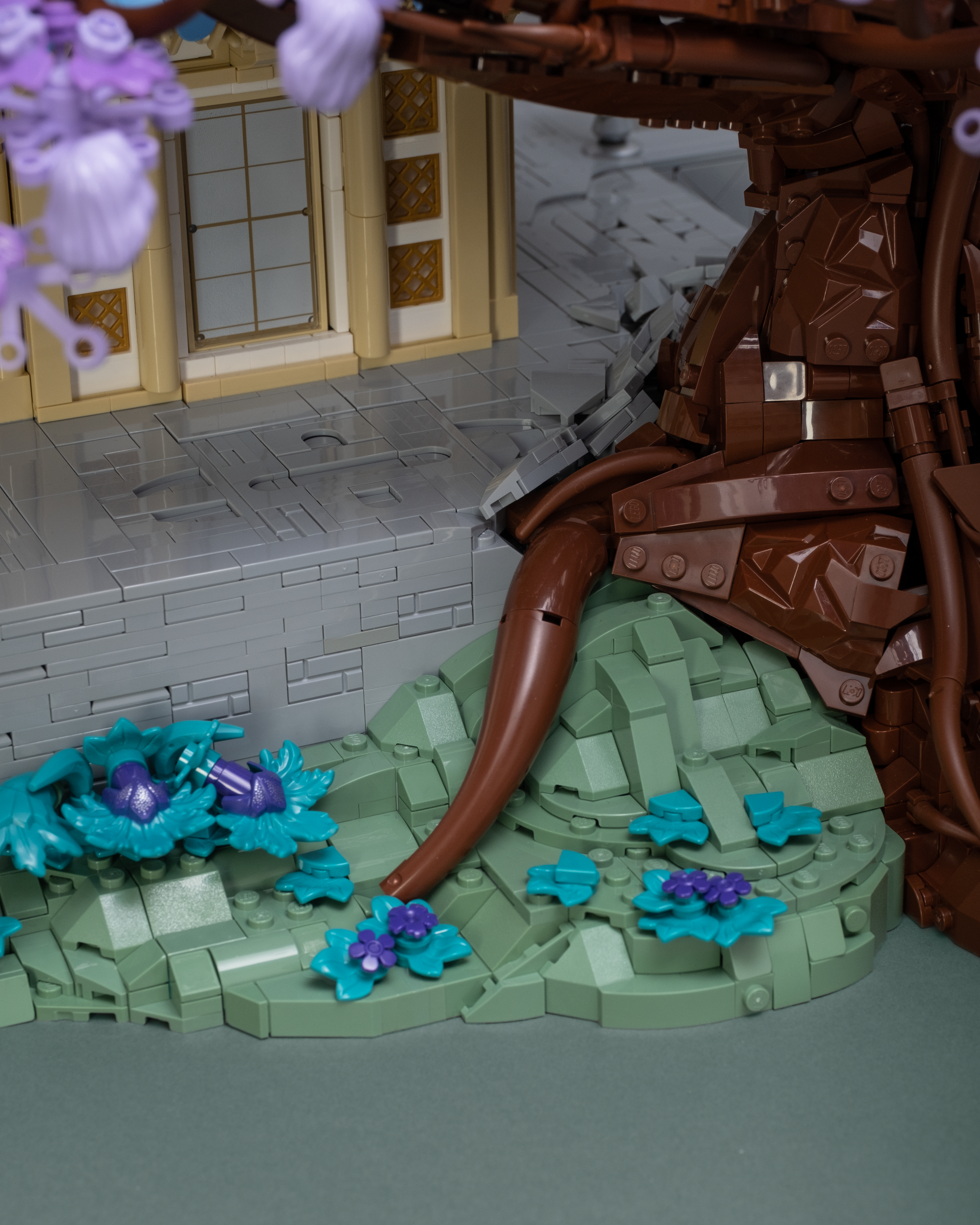

あたしは蛇になった体を釣鐘に巻きつけ、尾で鐘を叩き、火炎を吐いた。
("I wrapped my transformed body around the bell, struck it with my tail, and spewed flames.")
In comparison to the decorative tower, I intended the base to be more uncluttered. It therefore lacks any fencing or statues and is kept entirely in light bluish grey (Colour-ID 86). Still, it needed to look like a realistic stone pedestal, which was achieved by making it appear more deteriorated through the usage of ingots (Part-ID 99563), cobbled bricks (Part-ID 98283) and parts in light grey (Colour-ID 9). To avoid the platform looking too plain, I added floor patterns which are recessed by half a plate. These are particularly noticeable in front of the stairs where they taper in circular shapes towards the entrance of the tower.
For the flora surrounding the base, I initially built it completely in dark turquoise (Colour-ID 39). I thought that colour would match well with the ones used for the tree and the tower while also underlining the mythical vibe of the build. But it turned out to be too dark and too saturated so I switched to sand green (Colour-ID 48) for the base, with only the plants remaining in dark turquoise. I had the idea to use the LEGO® Minifigure headpiece of the Cabaret Singer (Part-ID 69951pb01) from the Collectible Minifigure Series 21 for a flower design before even really starting this project. Since that part has a marking in dark purple, I used that colour (Colour-ID 89) for the other flower petals (Part-ID 93080h and 93080g) as well.
Whenever I am free to design without a clear, singular inspiration, I try to make the work more self-referential. For instance, the pagoda has three stories as does the modern Dōjōji. The sōrin, the spear-like structure at the top of the tower, has many horn-shaped pieces (Part-ID 86125e and 10909) at its base, imitating the claws of the dragon. Above that, it has five large golden rings (Part-ID 2815), mimicking the five main roofs of the tower itself. In between, there are seven smaller golden dishes (Part-ID 4740), referencing the seven roofs in total. The number five comes up in other places as well. The stone railing next to the stairs, for example, has five hammers (Part-ID 75904) incorporated on each side. The word for five in Japanese is 五 [go] and is phonetically identical to a prefix-honorific. At shrines it is common to donate five Yen, as its name ごえん [goen] can also stand for a 'good connection'. It is therefore a number with a positive and important association.
I do believe there is a strong sense of aesthetic embedded into this system of repeating numbers and patterns. Quoting them gives a structure homogeneity and a feeling of completeness. However, nature does not necessarily adhere to this manmade order. Natural chaos, at least aesthetically, is at a constant contest with structured approaches in architecture. In my opinion true beauty stems from the equilibrium of these two extremes. The inevitable coexistence of uncontrolled whims and systematic, methodical design. To me, this work is symbolic of the embrace of these two sides.

